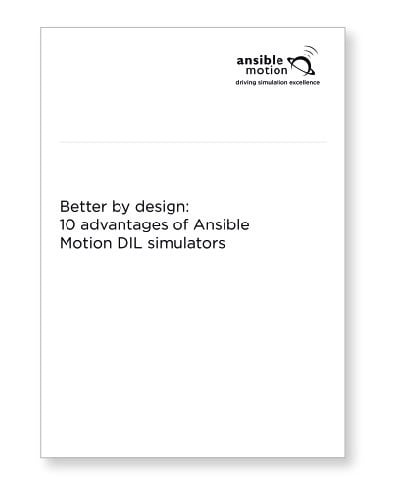 As automotive OEMs turn to virtual solutions to speed up their development work, a simulation specialist explains to Louise Davis how this approach delivers the freedom that allows engineers to push boundaries
As automotive OEMs turn to virtual solutions to speed up their development work, a simulation specialist explains to Louise Davis how this approach delivers the freedom that allows engineers to push boundaries
For automotive manufacturers, the benefits of simulation over real-world testing are multi-faceted, believes Ian Haigh, solutions manager at Ansible Motion. Haigh explains:
OEMs are under growing pressure to develop their increasingly complex vehicles more quickly, at higher quality and at lower costs using cutting-edge technology, all while remaining environmentally sustainable. This is what our products enable customers to do; meet changing demands from a rapidly evolving industry.
The products Haigh refers to are the British firm’s Driver-in-the-Loop (DIL) simulators, notably its flagship range, the Delta series. And one of their biggest selling points, according to Haigh, is the freedom they offer engineers in terms of creativity. Haigh explains this as follows:
When DIL simulation is included in advance of physical prototype construction, or in parallel with it, engineers can evaluate new concepts at the earliest stages with low risk. This gives them considerably more freedom to consider novel solutions that would perhaps be deemed too costly or time-consuming to pursue in the real world. As has been proven many times, some of the most original and revolutionary advancements in automotive technology were born from giving engineers the freedom to push boundaries and ‘be engineers.’ DIL simulation, by its very nature, encourages technical exploration and concept evaluation. This is because vehicle and environment changes occur with keystrokes instead of physical changes and because the virtual world is a risk-free space where edge cases (and beyond) can be safely explored.

WORLD IN MOTION
Ansible Motion has put a great deal of effort into developing products that deliver the above mentioned freedom in the most accurate, intuitive and results-driven way for their users. The latest iteration – the Delta Stratiform 3 (S3) – uses the company’s proprietary ‘six degrees of freedom’ motion system, which it describes as feature-rich and highly scalable for different applications. On this, Haigh comments:
Our DIL simulators produce high accelerations, high velocities, large displacements with high bandwidth, plus precise, low-latency dynamics for convincing reproduction of even the most subtle vehicle attributes. Many key driving manoeuvres can be conducted 1:1 with the real world, for unmatched realism. It is a turnkey sensory immersion system, with everything required for convincing virtual test driving – including a 360°, 48K wrap-around projection screen with detailed world-space scenarios, quick-change cabin environments, and full integration of hardware- and software-in-the-loop elements. The idea is to provide test drivers and vehicle evaluators with a laboratory-based experience that matches real-world test driving as closely as possible.
Bringing sophisticated products to market faster than competitors, while simultaneously improving quality and reducing environmental impact is vitally important to automotive manufacturers. Expanding on that, Haigh says:
Manufacturers are able to learn a huge amount from real human interaction far earlier in the development process, providing opportunities to make significant improvements sooner rather than later, thereby avoiding costly mistakes and ensuring marketplace acceptance of new concepts that can provide a competitive edge.
CUSTOMER SATISFACTION
Naturally, Ansible Motion’s hardware must be able to work alongside its customers’ own software. Maintaining this scope for customisation and upgrade paths is how Ansible Motion ensures that its simulators stay ahead of the curve. Haigh explains:
It’s important that we remain at the leading edge and anticipate the changing requirements of our customers. Often this has to do with integrating emerging technologies related to vision and computation systems – which are sometimes intimately related. For example, being able to integrate new graphics processing units (GPUs) as they become available on the market is a common upgrade path that can noticeably improve our customers’ experience.”
As the company supplies a broad range of interchangeable simulator subsystems that can be integrated independently or added to existing DIL simulators to equip them with the latest tech, this flexibility is fundamental to its business model.
Read the full article on the International Transport Manufacturer website.



